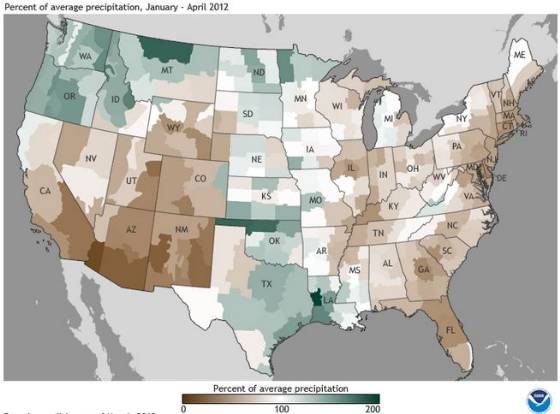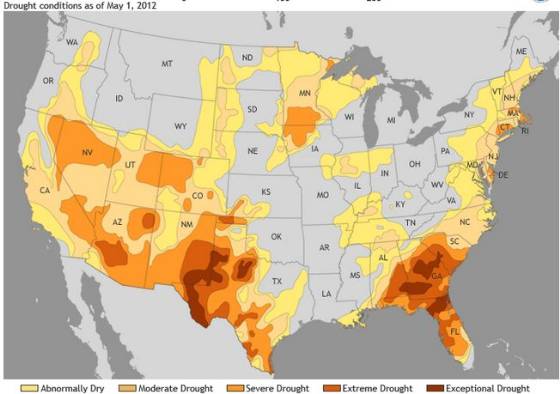It is dry in much of the southwestern and eastern United States
Average precipitation, January through April, 2012:
Drought conditions as of May 1, 2012:
Escaped prescribed fires complicate future projects in Australia
Last year we first wrote about the prescribed fire in Leeuwin-Naturaliste National Park that escaped on November 23, 2011 and pushed by strong winds, destroyed 40 structures and burned over 8,400 acres in western Australia. Residents who had refused to evacuate later had to take refuge from the fire at the ocean on a beach. They were rescued by jet ski and ferried to a search and rescue boat offshore. The report on the incident was very critical of the government’s prescribed fire program, saying some employees of the Department of Environment and Conservation were overworked and performing above their skill levels.
A recent article in The Independent examines further the prescribed fire program in Australia in light of the recent failures. Here is an excerpt:
…A lobby group called the Bush Fire Front, which was set up by a group of retired foresters in western Australia, is also predicting dire consequences unless the burning programme is “greatly expanded”. The Front’s chairman, Roger Underwood, deplores a backlash against DEC’s staff, who have stopped wearing uniforms after being hissed at and abused in the Margaret River shops.
“DEC has been looking after their fire safety for years, doing all the dirty work,” says Mr Underwood. “They make one mistake and are crucified for it.”
However, as locals point out, it was not just one mistake. On the day of the fire, another controlled burn escaped near Nannup, east of Margaret River, incinerating 125,000 acres of national park and state forest, and damaging a farm part-owned by Stewart and Alison Scott. Mr Scott was about to start the afternoon’s milking when he saw flames sweeping towards his property. He dashed over to warn his family, but the smoke was so thick that one of his farmhands – who had leapt on a quad bike – collided with a car. The man suffered head injuries and spent months in Royal Perth Hospital.
California wildfire burns structures
A wildfire near Acton, California in southern California yesterday burned 126 acres and several structures. Inspector Quvondo Johnson of Los Angeles County Fire Department said an aggressive air attack, which included five helicopters and fixed wing air tankers, helped the crews on the ground contain the fire.
CAL FIRE sent S-2 air tankers from Porterville and Hemet, 120 miles and 90 miles from the fire, respectively. There were no federal air tankers at the air tanker base at Landcaster, 18 miles from the fire. The DC-10 very large air tankers are based at Victorville, 60 miles east of Acton.
Is fire suppression causing water shortages?
An opinion piece in the LA Times claims the 100-year old policy of wildfire suppression in the United States has caused water shortages. The theory is that over-stocked forests that have become that way due to successful suppression of fires, have locked up moisture in the trees and reduced runoff. Here is an excerpt from the article:
Today, the hottest and thirstiest parts of the United States are best described as over-forested. Vigorous federal protection has stocked semiarid regions of public land with several billion trees too many. And day after day these excess trees deplete a natural resource that has become far more precious than toilet paper or 2-by-4’s: water.
I will have to go on record as being skeptical of this trees-causing-water-shortage theory.
2011 summary of incident reviews
The Wildfire Lessons Learned Center has released a report summarizing the information gleaned from the seventy-eight 2011 incident review reports—from various agencies—submitted to and gathered by the LLC.
New Mexico establishes fire notification system
The state of New Mexico has established a system by which residents can be notified about wildfires. Emails will contain information including when the fire started, the cause, and a description of threatened homes and communities. For now, the system will send people who sign up for the service information about all fires within the state. Later it will be refined so that notifications can be filtered to more specific locations, such as counties. Anyone can sign up HERE.
Thanks go out to Johnny and Dick.




If using the “CA model”, one would have to assume (and make LOTS of assumptions) that the “normal” CA fire regime has been altered by fire suppression. Facts and common sense say otherwise.
For folks touting “success” in IA leading to “un-natural fuel conditions”, PLEASE consider the FACT that IA is nearly 300% of “historic” levels… and IA “efficiency” (fires caught less than 10 acres) is ONLY about 60-70%.
Far MORE land is burning now in CA and being “type converted” from WATERSHED to grasslands…..
Facts on file.
Is there anyone that can see this fire season coming? California politicians who don’t live in the wildlands really don’t care. Gov. Moonbeams pet project is the bullet train. I like trains. Trains have always been part of fire history. Railroads usually have dedicated “fire trains” in or near wildland areas. Example, is the fire train located in Truckee, Ca. which responds to fires over the Sierra Nevada east-west line. A suggestion is to start reasearching (RANDS) the possiblity of a bullet train fire suppression apparatus. There are railroad tracks everywhere in Ca. The Fire Attack Response Train, which it will be called, will replace the hundreds of fire fighters who lost their jobs, initial attack bulldozers, VLAT’s and an air tanker base. I invision these bullet fire depots located throughout Ca. Instead of “there has to be a road out ahead of this thing, now there has to be a railroad track in its direction.” I’m going to check with my attorney to see if I can register trademark Fire Attack Response Train, sort of on the same idea as “4 LESS”.
Bill-
While I’m not sure I’d use the term “shortage” numerous studies have shown that streamflow levels increase post timber harvest due to a decrease in evapotransipiration.
If a watershed has tree densities that are uncharacteristically high due fire suppression, you would likely see a decrease in water levels, though probably due to increased evapotranspiration than it being “locked-up” in the trees themselves.
MD, it is a very complicated issue, and you’re right about stream flow levels increasing after fires and timber harvests. This is common on a micro-climate or very local level. I was considering a larger scale, and what happens to the total amount of water in the vegetation, ground, and the air. Considerations include runoff, stream flows, where the water in the stream goes (reservoirs, lakes, oceans), evapotranspiration, evaporation, and what happens to the moisture that ends up in the atmosphere.